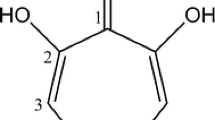Abstract
The production of siderophores by four Streptomyces strains, S. ambofaciens, S. coelicolor, S. lividans, and S. viridosporus, was studied under iron-limited conditions. S. viridosporus produced two different siderophores: the linear desferrioxamine B and the cyclic desferrioxamine E. The latter was produced by the other strains and was the main siderophore of S. ambofaciens. The linear desferrioxamine G was the major form of S. coelicolor and S. lividans. The uptake rates of 55Fe-labeled ferrioxamines by S. lividans and S. viridosporus showed that the G form was incorporated less efficiently than the B and E forms.
Similar content being viewed by others
Literature Cited
Berner I, Winkelmann G (1990) Ferrioxamine transport mutants and the identification of the ferrioxamine receptor protein FoxA in Erwinia herbicola (Enterobacter agglomerans). Biol Metals 2:197–202
Berner I, Konetschny-Rapp S, Jung G, Winkelmann G (1988) Characterization of ferrioxamine E as the principal siderophore of Erwinia herbicola (Enterobacter agglomerans). Biol Metals 1:51–56
Bickel H, Bosshardt R, Gaümann E, Reusser P, Vischer E, Voser W, Wettstein A, Zähner H (1960) Stoffwechsel-Produkte von Actinomyceten, über die Isolierung und Charakterisierung der Ferrioxamine A-F, neuer Wuchsstoff der Sideramin-Gruppe. Helv Chim Acta 43:2118–2128
Echenique JR, Arienti H, Tolmasky ME, Read RR, Staneloni RJ, Crosa JH, Actis LA (1992) Characterization of a highaffinity iron transport system in Acinetobacter baumannii. J Bacteriol 174:7670–7679
Gusek TW, Kinsella JE (1992) Review of the Streptomyces lividans/ vector pIJ702 system for gene cloning. CRC Crit Rev Microbiol 18:247–260
Hopwood DA, Kieser T (1990) The Streptomyces genome. In: Drlica K, Riley M (eds) The bacterial chromosome. Washington, DC: American Society for Microbiology, pp 147–162
Kontchou CY, Blondeau R (1992) Biodegradation of soil humic acids by Streptomyces viridosporus. Can J Microbiol 38:203–208
Leblond P, Demuyter P, Simonet JM, Decaris B (1990) Genetic instability and hypervariability in Streptomyces ambofaciens: towards an understanding of a mechanism of genome plasticity. Mol Microbiol 4:707–714
Meiwes J, Fiedler HP, Zähner H, Konetschny-Rapp S, Jung G (1990) Production of desferrioxamine E and new analogues by directed fermentation and feeding fermentation. Appl Microbiol Biotechnol 32:505–510
Meyer JM, Abdallah MA (1980) The siderochromes of nonfluorescent pseudomonads: production of nocardamine by Pseudomonas stutzen J Gen Microbiol 118:125–129
Müller G, Raymond KN (1984) Specificity and mechanism of ferrioxamine-mediated iron transport in Streptomyces pilosus. J Bacteriol 160:304–312
Müller G, Zähner H (1968) Stoffwechselprodukte von Mikroorganismen. 65. Ferrioxamine aus Eubacteriales. Arch Mikrobiol 62:257–263
Nelson M, Carrano CJ, Szaniszlo PJ (1992) Identification of the ferrioxamine B receptor, FoxB, in Escherichia coli K12. BioMetals 5:37–46
Persmark M, Expert D, Neilands JB (1992) Ferric iron uptake in Erwinia chrysanthemi mediated by chrysobactin and related catechol-type compounds. J Bacteriol 174:4783–4789
Peter HH (1985) Industrial aspects of iron chelators: pharmaceutical application. In: Spik G, Montreuil J, Crichton RR, Mazurier J (eds) Proteins of iron storage and transport. Amsterdam: Elsevier, pp 293–303
Rabsch W, Winkelmann G (1991) The specificity of bacterial siderophore receptors probed by bioassays. Biol Metals 4:244–250
Ramachandra M, Crawford DL, Hertel G (1988) Characterization of an extracellular lignin peroxidase of the lignocellulolytic actinomycete Streptomyces viridosporus. Appl Environ Microbiol 54:3057–3063
Reissbrodt R, Rabsch W, Chapeaurouge A, Jung G, Winkelmann G (1990) Isolation and identification of ferrioxamine G and E in Hafnia alvei. Biol Metals 3:54–60
Schafft M, Diekmann H (1978) Cadaverin ist ein Zwischenprodukt der Biosynthese von Arthrobactin und Ferrioxamin E. Arch Microbiol 117:203–207
Schneider R, Hantke K (1993) Iron-hydroxamate uptake systems in Bacillus subtilis: identification of a lipoprotein as a part of a binding protein-dependent transport system. Mol Microbiol 8:111–121
Schwyn B, Neilands JB (1987) Universal chemical assay for the detection and determination of siderophores. Anal Biochem 160:47–56
Stoll A, Brack A, Renz J (1951) Nocardamin, ein neues Antibioticum aus einer Nocardia. Art Schweiz Pathol Bakteriol 14:225–233
Takahashi A, Nakamura H, Kameyama T, Kurasawa S, Naganawa H, Okami Y, Takeuchi T, Umezawa H (1987) Bisucaberin, a new siderophore, sensitizing tumor cells to macrophage-mediated cytolysis. II.-Physico-chemical properties and structure determination. J Antibiot 40:1671–1676
Author information
Authors and Affiliations
Rights and permissions
About this article
Cite this article
Imbert, M., Béchet, M. & Blondeau, R. Comparison of the main siderophores produced by some species of Streptomyces . Current Microbiology 31, 129–133 (1995). https://doi.org/10.1007/BF00294289
Issue Date:
DOI: https://doi.org/10.1007/BF00294289




